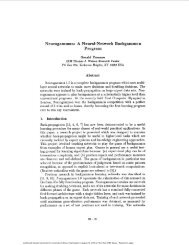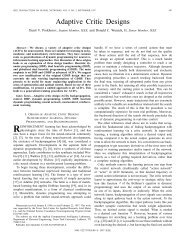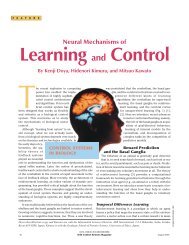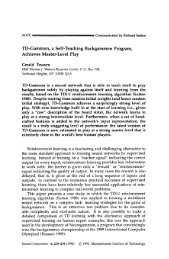Neural-Network-Based State Feedback Control of a ... - IEEE Xplore
Neural-Network-Based State Feedback Control of a ... - IEEE Xplore
Neural-Network-Based State Feedback Control of a ... - IEEE Xplore
You also want an ePaper? Increase the reach of your titles
YUMPU automatically turns print PDFs into web optimized ePapers that Google loves.
JAGANNATHAN AND HE: NN-BASED STATE FEEDBACK CONTROL OF A NONLINEAR DISCRETE-TIME SYSTEM 2085<br />
APPENDIX<br />
Pro<strong>of</strong> <strong>of</strong> Theorem 1: Define the Lyapunov function candidate<br />
(A.1)<br />
where and are the upper bounds <strong>of</strong> function and<br />
, respectively, given a compact set (see Assumption 2), and<br />
, , and are design parameters (see Theorem 1).<br />
The first difference <strong>of</strong> Lyapunov function is given by<br />
(A.2)<br />
The first difference<br />
is obtained using (13) as<br />
(A.6)<br />
Combine (A.3), (A.4), (A.5), and (A.6) to get the first difference<br />
and simplify to get<br />
(A.3)<br />
Now take the second term in the first difference (A.1) and<br />
substitute (19) into (A.1) to get<br />
(A.4)<br />
Take the third term in (A.1) and substitute the weights updates<br />
from (23) and simplify to get<br />
(A.5)<br />
Take the fourth term in (A.1) and substitute the weights updates<br />
from (24) and simplify to get<br />
This implies that<br />
and<br />
(A.7)<br />
as long as (25) through (28) hold<br />
(A.8)









